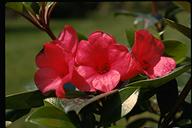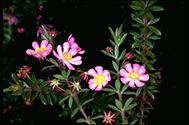

 |
Australian National Botanic Gardens
|
 |
A weekly news sheet prepared by a Gardens' volunteer.
Numbers in square brackets [] refer to garden bed Sections.
Plants in flower are in bold type.
18 November 2005
 |
|
Rhododendron lochiae - click for larger image |
As bottlebrushes are flowering in many places, a few will be mentioned but first discover the beauty of our own Rhododendron lochiae [Section 210]. It is an open shrub with shiny green leaves and orange-red loose bell-like flowers. Bottlebrushes include Callistemon ‘Howie’s Fire Glow’ [Section 124] with fiery red bottlebrushes. Callistemon ‘Harkness’ [Section 124] with upright grooved trunk has lovely red bottlebrush flowers on arching branches. Callistemon salignus [Section 107] is quite tall with many trunks and the willowy habit is covered with pink flowers. Around the corner Callistemon ‘Glasshouse Country’ [Section 110]is an upright shrub also with pink bottlebrushes. Nearby Melaleuca fulgens [Section 110] is an open shrub the lateral branches holding red bottlebrush flowers.
Now wander across via any floral lined path to the Sydney Basin. Pass a corner of Flannel Flowers, Actinotus helianthi [Section 191h] with lovely grey foliage and white velvety flowers, to the far side of the gully. At the entrance Epacris longiflora [Section 191f] is bright with red tubular flowers tipped with white on long straggly stems, and Tetratheca thymifolia [Section 191f] is upright with pink downturned flowers. These two are surrounded by the deep blue flowers of the suckering Dampiera purpurea [Section 191f]. Edging the narrow path Boronia pinnata [Section 191f] is radiant with its soft pink opening star flowers. A scattering of small upright plants with heads of tiny tubular mauve flowers is that of Conospermum tenuifolium [Section 191f]. Phyllota humifusa [Section 191f] is a dense groundcover bright with orange- yellow pea shaped flowers. Isopogon anemonifolius [Section 191f] has prominent terminal yellow flowers with the fine divided leaves on an upright open shrub. The greyish pink smooth trunk of Angophora costatasubsp. costata [Section 191f] is worth admiring. So is the twining ground cover, Hibbertia dentata [Section 191f], with large yellow flowers covering the bank.
 |
Bauera rubioides - click for larger image |
Pass the descending stairs. Sit awhile in this bushland setting. Listen to the calls of birds including the laugh of the Kookaburra, the solemn call of a Cuckoo and the chatter of the Crimson Rosella and the Currawong. Behind the seat is a scattering of Olearia quercifolia [Section 191f] with large white daisy-like flowers on upright stems. Dampiera purpurea [Section 191f] adds its deep blue colour while further back, Boronia microphylla [Section 191f] is a small rounded shrub well covered with bright pink flowers. The gully continues to be clad with the large fronds of the fern Dicksonia antarctica [Section 191j, 191d] and others.
Continuing, River Rose, Bauera rubioides [Section 191j] has pink many petalled flowers covering, in profusion, the dense spreading shrub. Hibbertia pedunculata [Section191f] reveals its small yellow flowers over the dense groundcover. At the corner Leptospermum macrocarpum [Section 191j] is an upright old woody shrub with splendid flowers coloured pink or red with green-cream centres. The other side is Melaleuca capitata [Section 191f] small and dense with terminal globular mauve flower heads. (This walk could continue to the Display Glasshouse, which always has a few colourful orchids).
Pleasant walking… such flowers!
Barbara Daly